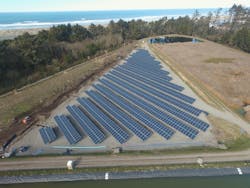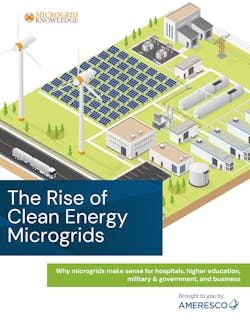Community Microgrids: Navigating Roadblocks to Implementation
Grid outages caused by adverse weather are wreaking havoc on critical infrastructure. Exacerbated by climate change, they are causing more extensive loss of services with bigger financial and safety impacts than ever before. Water and wastewater treatment facilities are especially at risk because power loss can cause sewage to build up and overflow or prevent drinking water from being supplied to the community, jeopardizing public health. A recent example is the impact of Hurricane Ian on Polk County, Florida, that caused tens of millions of gallons of sewage and recycled water to leak, endangering public health with the release of contaminated water into the environment.
Additionally, emissions produced by water facilities are expected to quadruple by 2040 because of rising demand for increasingly limited water resources as well as the need for energy-intensive solutions like desalination to supply fresh water to more than 8 billion people around the world. This is prompting many water treatment facilities to consider microgrids as a solution.
Located along the Pacific Ocean in California, McKinleyville Community Services District (MCSD) had been struggling for years to get a microgrid backup power solution installed. Various sources of outages – earthquakes, wildfires and Pacific Gas & Electric (PG&E) safety shutdowns because of potential wildfire conditions – rendered its existing backup diesel generator as the only source of power to the site during outages. At risk were systems that could not operate properly without power, including sensitive wastewater treatment plant processes. Loss of power for more than a 30-minute duration would put the facility at risk of millions of dollars worth of potential damage to its system biology and could affect water quality discharges to public waterways. As such, having additional resiliency and another power source when utility power was not available was critical for the facility. Northern California has recently endured various public safety power shutoff periods, some lasting for days depending on the area, with no utility power available to the service area. MCSD wanted to implement a microgrid to minimize diesel generator greenhouse gas environmental impacts while keeping its plant operating and continuing service for the community in a sustainable fashion.
To solve these issues, the district needed a partner that could help it optimize electrical grid resiliency while delivering both financial and environmental benefits to the community. While there was an existing grant from the local water authority, additional funding from the Inflation Reduction Act (IRA) enabled MCSD to work outside of existing grant dollars to satisfy all remaining, highly complex requirements. The district could recognize value from the IRA, which funds 30% of a clean energy project once it meets commercial operation requirements. This could dramatically lower the cost of the project, which had rigorous engineering, design, permitting and construction requirements.
There were numerous reasons the project had not proceeded over the years. The site itself presented some unique challenges, especially the plan to co-locate the solar array in a nearby dog park, which faced widespread public opposition. After attending public district meetings and speaking with local constituents, a course of action was identified that satisfied the public opposition and MCSD staff. Optimizing the planned battery storage system allowed for a best value approach to meeting the needs of the wastewater facility and the utility. Additional environmental constraints, such as a large forest that blocked access for the new system in a state with heavy oversight of tree removal, prevented siting the system at alternate preliminary locations earmarked for study.
It was proposed that a wetland pond that was not planned for reuse be repurposed for the microgrid. Entertaining this new opportunity added potential for the project to proceed but required new environmental assessments to study the impact on local plants and animals. To be certain no endangered species might be disturbed, the development teams went through the assessments multiple times until they were comfortable that this project could proceed. With new layouts and system designs that could produce as much energy as the treatment plant would consume, the district approved the project, permitting was granted, and the solar array system connection was approved by MCSD and PG&E.
Microgrid systems and battery technology for storing renewable energy that has been generated can cause additional system complexity. The proposed solution included a 500 kW direct current (DC) (583 kW DC) solar array and 250 kW/712 kWh battery energy storage, while still utilizing the existing 500 kW standby generator as backup when needed. Full integration and a controller system were implemented to tie these disparate elements together for resiliency and green power at the site. Microgrid systems are highly innovative, completely customized and relatively new. Even engineers at the utility level are just starting to understand how to integrate them within their plants, so partners must be willing to provide the necessary training.
The most important thing to remember with a complex engineered design is that teams will need to take their time and be creative with projects. Know when you are launching a project that it is going to take a lot of work with the utility to develop the microgrid and its controls, which is a major consideration in meeting utility specifications. Understand that supplies like batteries can be limited for the necessary product solutions. At the end of the day, getting the engineering right is critical and much more difficult than just a solar installation. Not all teams will be willing or able to do the heavy lifting to combine the pieces and parts together.
Microgrids provide a solution that is beneficial to communities and industry, boasting energy resilience, supporting net-zero transitions, lowering operating costs and boosting local workforce opportunities. Because of their capacity to provide sustainable energy with long-term cost savings, microgrids are increasingly acknowledged as trustworthy sources of power for emergency and other off-grid scenarios and as affordable options for reliable and renewable electricity. In addition to providing resilience in case of an emergency, they deliver financial and environmental benefits to the community through lower water utility rates, reducing the cost burden on the general public. Given the complexity of the project, MCSD opted to partner with Ameresco, a clean tech integrator.
By aligning with a team that would design and build this project in a way that best suited its needs, we were able to solve complex issues together, showing promise for many future microgrid projects. If you engage early, stay agile and maintain trust with your partners, complex microgrid design projects that boost safety and reliability can see the light of day, providing the blueprint for a more sustainable world.
Learn more about why microgrids make sense for communities, health care, higher education and more at: Microgrid | Free White Paper | Ameresco Microgrid Solutions









